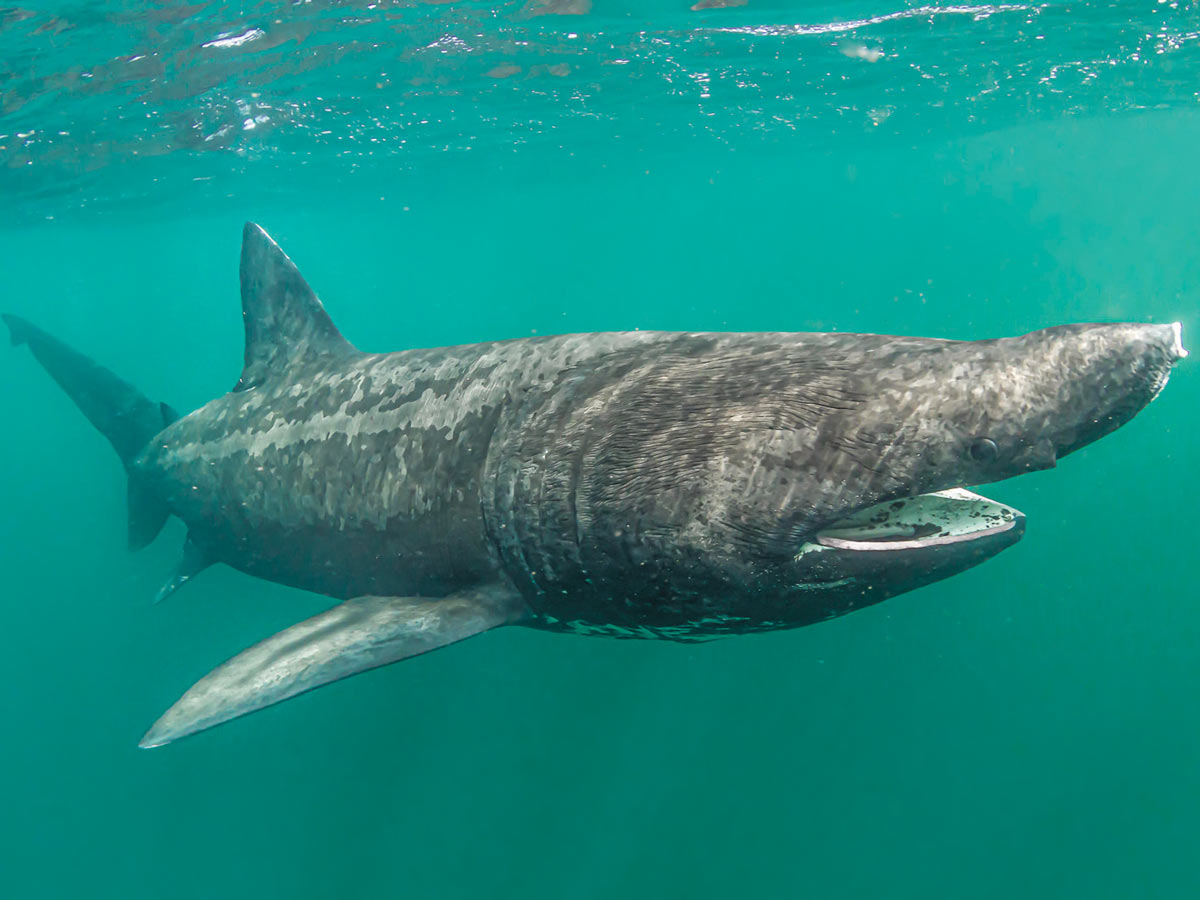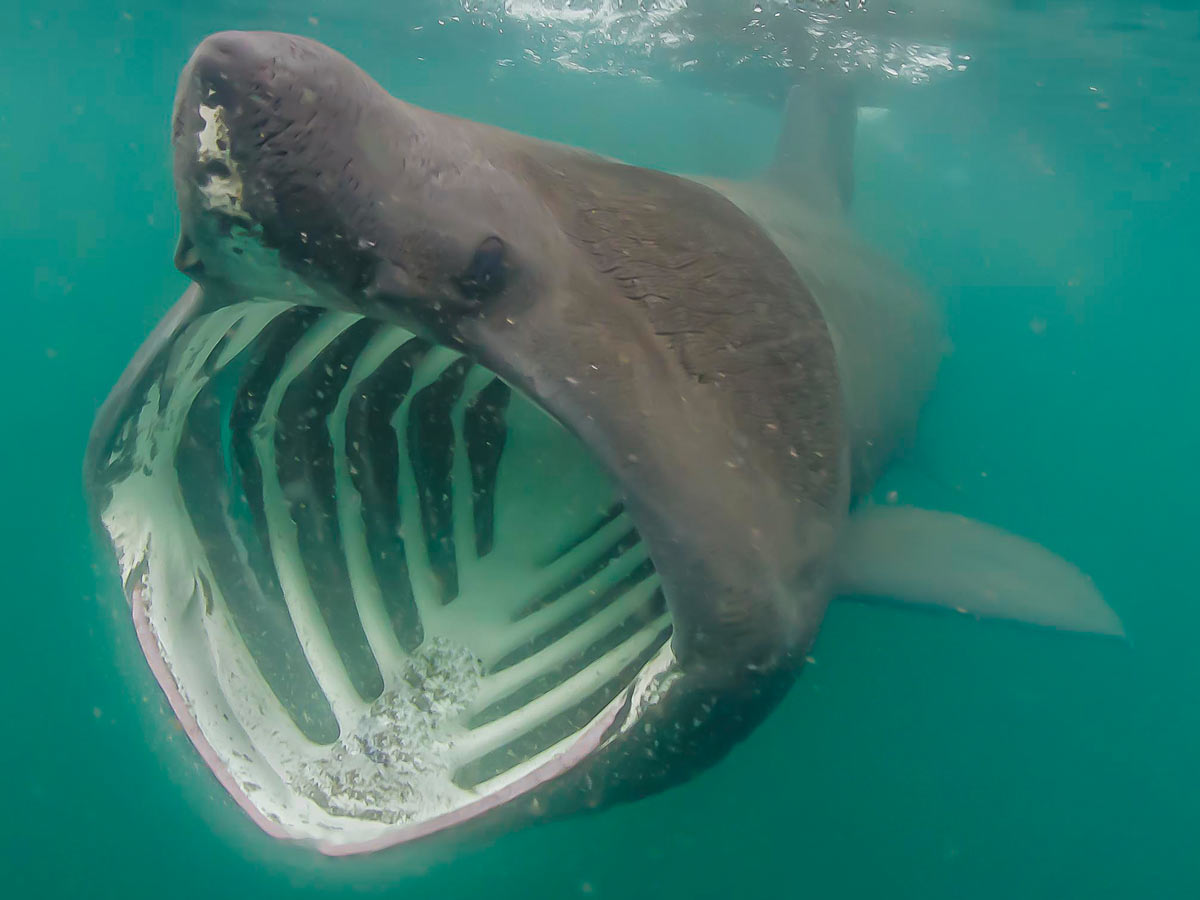In this issue’s marine life columns, we’ll examine the basking shark and the whale shark. Both are big. They flood your body with adrenaline every time you see one big. Both eat copious numbers of tiny organisms to gain and maintain their massive size. They have enormous mouths located at the front of their head. They appear to swim slowly but can easily outswim a diver. Both are fish. Both are sharks. In fact, they are the biggest and second biggest fishes in the sea, a fact that also makes them the biggest and second biggest sharks in the world. Both of these passive species are commonly referred to as gentle giants.
Not too many years ago, the price of an encounter with either species was one of the three wishes we are supposedly granted in life. While encounters continue to be held in high regard, these days sightings are far more common as the diving world has, at least to some degree, learned where to go and what to do to swim with basking sharks and whale sharks.
According to historical records, encounters in California waters with the world’s second biggest fish, the basking shark were common as late as the 1980s. Aggregations with a dozen to as many as 40 to 50 sharks were often sighted and what was thought to be a sustainable fishery existed from the 1920s through the 1960s. But in the 1970s and 1980s, fishing pressure along the Pacific coast of North America dramatically increased and the basking shark population was quickly reduced to the degree that some feared these sharks would never again grace California waters.
However, within the last decade, the number of sightings of basking sharks in Califonia has been on the rise, giving hope that basking shark encounters for California divers will increase as well.

Basking sharks grow to 45 feet, although the length of a typical adult is 20 to 26 feet. An average adult weighs as much as 11,000 pounds. Photo by Marty Snyderman.
FAMILY
The basking shark is the only species in the family Cetorhinidae, a name derived from the Greek ketos meaning “marine monster” or “whale” and rhinos meaning “nose.”
GENUS AND SPECIES
Cetorhinus maximus
DESCRIPTION
Basking sharks grow to 45 feet, although the length of a typical adult is 20 to 26 feet. An average adult weighs as much as 11,000 pounds. While size alone makes in-water identification relatively easy, a blackish to grayish-brown or bluish-gray body, mottled skin with irregular white blotches under the head and on the abdomen, long conical snout, five long gill slits on each side of their head, long pectoral fins, a tall dorsal fin, and huge mouth, make their identity easy to confirm. In addition, the white insides of the mouth tend to stand out in contrast to the darker greenish water where basking sharks often swim.
RANGE
The basking shark is a cosmopolitan species, meaning its distribution is very widespread. Worldwide, basking sharks are far more common in cold to warm temperate regions, as they prefer to inhabit areas where the water temperature is between 46° and 61° F.
HABITAT
Generally inhabiting the open sea, basking sharks are most commonly encountered nearshore in temperate areas where concentrations of planktonic prey are concentrated. They tend to swim between the surface and 6,652 feet. Basking sharks make extensive vertical and horizontal migrations as they move along continental shelves while seeking plankton-rich areas.
“Baskers,” as these sharks are sometimes referred to in other parts of the world, tend to be highly migratory as they follow concentrations of plankton. They are often seen alone, in pairs, or in groups of a dozen or more animals, and sightings with up to 50 basking sharks are common in areas with healthy populations. Gatherings of more than 1,000 animals have been verified.
Discoveries in recent years refute the long-held belief that basking sharks hibernate during winter. It is now known that basking sharks often undertake long migrations in deep water where they pursue concentrations of deep-water plankton.
FUN FACTS
One factor that prevents basking sharks from growing as big as a whale sharks is that basking sharks cannot open and close their mouth rapidly when feeding, thus their mouth does not function like a pump that sucks in plankton in the way the mouth of a whale shark does. Estimates are that a basking shark can filter 336,600 gallons of water per hour. That is about half the water in an Olympic size swimming pool. The jaws of basking sharks hold as many as 1,500 teeth. The tiny teeth are only about .25 inch long and serve no known useful function.
The oily liver, an organ that provides considerable buoyancy, makes up approximately 25 percent of a basking shark’s body weight. A basking shark’s pectoral fins and dorsal fins can reach six feet in length, and its cavernous mouth can open more than three feet wide. It is estimated that basking sharks live as long as 50 years in the wild. Once believed to lay eggs, basking sharks are ovoviviparous, meaning they develop from eggs that remain in the mother’s body until the young hatch. Soon afterwards, the relatively well-developed young are released, or “born” live. Basking sharks have the smallest known brain weight-to-body weight ratio of all sharks.









